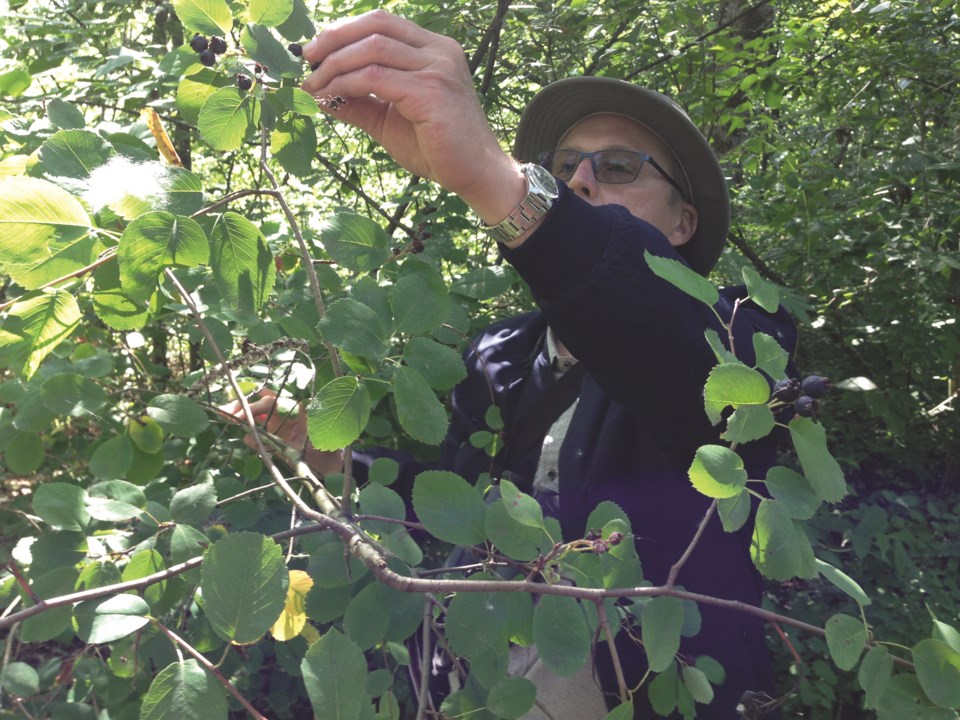We humans haven’t exactly been thrilled by this year’s cool, wet start to summer. But our wild fish and amphibians sure have been and, if plants could talk, they’d totally agree.
Growers throughout the Sea to Sky region are reporting some of their best crops ever. With my tiny, but flourishing, patio garden, I’ll modestly count myself amongst them. And if you’ve been out on the trails getting your “nature bath” lately, I bet you’ve spotted some of the best-looking wild berries in years. Step 2 is bothering to stop and taste a few. If you do, you’ll discover that this year’s wild berry crop is also one of the tastiest ever.
Last weekend, I was amazed how many people simply kept walking (or jogging) as we were gorging like hungry critters on sweet, delicious thimbleberries and Saskatoons (some call them service berries). So here’s a friendly nudge from me and ecologist and Whistler Naturalists founder, Bob Brett: Get out there and enjoy a wild berry feast.
To get you started, here are some tasty tips.
1. Go with someone who knows
While growing up in Alberta, my parents and grandparents taught us to love wild berries. It was a much-anticipated treat in summer to pick the wild blueberries, strawberries and Saskatoon berries in the meadows and forests around Edmonton. As kids, we were lucky enough to learn, naturally, from our elders who’d been there, done that for decades. They in turn had learned from their elders, since there wasn’t exactly a store down the road in 1800s rural Canada. Nothing like some Saskatoon berry jam to brighten up a long winter.
Our Indigenous neighbours, whose ancestors were living here way longer, have relied on wild berries and plants for thousands of years and learned much the same way—passing along knowledge through the generations.
First, an experienced berry hunter can show you where the best pickin’ is (more on that in a minute). Second, some berries out there aren’t exactly good for you (more on that, too).
The best, safest way to learn where, when and what to pick is from a real, live person who knows the ropes, or at least the local berries.
2. If you can’t find someone who knows, then get a good book
I laughed when British Columbia Magazine—a source usually considered reliable—ran a feature on B.C.’s wild berries and included white mulberry. Bzzzt. Not! If you find them in the wild at all, it’s going to be southern Ontario. Also, white mulberry, which was introduced from Asia in the 1800s, is considered a tree killer by Tree Canada.
Sure, you can go online to some reliably reliable sources for IDing berries and other wild plants, like the Royal BC Museum website and UBC’s E-Flora BC. Even Bob has a fun article on the Whistler Naturalists’ site on wild berries and includes some of his favourites—berries that are blue (and sometimes black or red) versus blueberries themselves, which also grow around Whistler. Tops in that category: black huckleberries.
But you can’t beat a good nature guidebook when you’re out in nature versus squinting at a wee screen in bright sunlight.
For a good field guide—wait, did I say good? How about the best? You can’t beat Plants of Coast British Columbia by Jim Pojar and Andy “Fungus Among Us” MacKinnon. Plants from Oregon to Alaska are included, but the guide is so clear you won’t get muddled. The excellent photos and illustrations and concise, focused text—which includes word etymologies; traditional and historic uses; and all kinds of anecdotes—provides more good rabbit holes to go down than an internet search. Armchair Books in Whistler Village stocks it. Wild Berries of British Columbia is also excellent, if you can find it. Sadly, it’s out of print.
Once you get your guidebook, you can look up two more, usually overlooked, Bob favourites: Bunchberries, which are more fun to eat than tasty. Nicknamed crackleberries, they have a centre with seeds that pops open when you crunch down. Best not to eat too many, he advises.
Then there’s the five-leaved bramble—miniature fruits related to blackberries and raspberries, and found mainly in subalpine locations. They have one to six drupelets (the individual parts of the fruit that make up blackberries and raspberries) that Bob really likes, plus they’re slightly astringent and leave a clean taste in your (or at least his) mouth.
3. If you can’t be bothered with 1 or 2, don’t worry too much
As usual in the wild, common sense rules. It’s best to only eat berries, or any other plant parts, you can identify. At the very least, if you don’t know what it is, just have a little nip.
Given the pandemic, Whistler Naturalists aren’t doing any guided tours right now to teach us directly about wild-berry bounty. But I love what Bob has to say about wild berries in general: “You have to really go out of your way to poison yourself.”
There is one berry, though, to avoid. Baneberries are pretty much the only berries around Whistler that are poisonous. So here’s another Bob tip: Avoid berries that look like snooker balls—meaning, they’re opaque, and either red or white.
Baneberries, which, as the name suggests, could be the bane of you, look like snooker balls. (The Anglo-Saxon bana means “murderous.”) Lots of others might not taste good, he says, like berries from Oregon grape or Solomon’s seal, but they won’t cause you harm.
Also, avoid berries along busy roads, since they’re coated in pollution, and near railway rights-of-way, since train companies spray pesticides to kill unwanted plants.
Other than that, pick and eat away—the berries, right? And have fun!
Glenda Bartosh is an award-wining journalist who loves the fact that most of the berries we eat are from the rose family.




